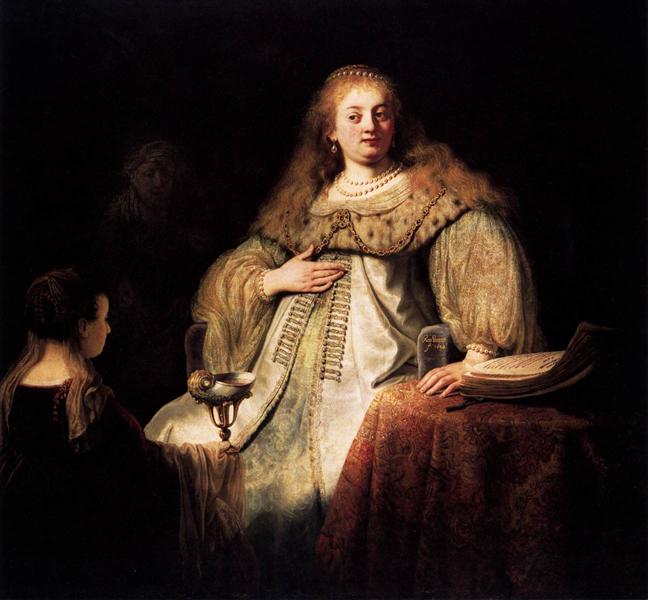Descriere
Rembrandt's 1634 work Artemisia is part of the Dutch master's vast corpus of painting, who is renowned for his mastery of chiaroscuro and his ability to capture humanity in his portraits. In this work, Rembrandt depicts a woman with a penetrating gaze and dignified bearing, who has been identified as Artemisia Gentileschi, one of the most prominent painters of the Baroque period. The choice of Artemisia as a subject is notable not only for her artistic talent, but also for her relevance as a figure who challenged the conventions of her time, making the work a tribute to her strength and creativity.
The composition of the painting is marked by a subtle balance between figure and background. Born from his characteristic style, Rembrandt employs a dark background that contrasts with the luminosity of Artemisia's figure. The use of chiaroscuro, a technique that brings light and shadow into dialogue, allows the painter's face to stand out in a monumental way, filling the composition with a profound sense of three-dimensionality. Rembrandt also manages to capture the essence of her character through an intimate and contemplative representation. Artemisia's expression is situated in a space that seems to transcend the mere portrait to delve into the representation of her emotions and thoughts.
The color in “Artemisia” is another facet worth exploring. Rembrandt’s palette is composed of earthy tones, rich in nuances, evoking a sense of warmth and humanity. The figure’s dark clothing contrasts with the soft glow of her skin, adding a touch of realism that resonates with the master’s technique in depicting natural light. In his works, Rembrandt often prioritizes texture and color, and in “Artemisia” he achieves a combination that reinforces the personal strength of his model.
The narrative elements present in the painting are subtle but significant. The theme of the female artist is central to this work. Artemisia Gentileschi is not only depicted as a capable artist, but also as a woman who has made her way in a male-dominated world, adding a feminist dimension to the work that has been the subject of study and analysis in contemporary contexts. This work also aligns with other portraits of female artists of the period, although Rembrandt's approach is uniquely introspective and insightful.
The choice of Artemisia as a model can be interpreted as a reflection on artistic identity; it is a call to recognize female talent in a period in which it was often obscured. In this sense, the painting transcends time and becomes a symbol of the fight for equality in the artistic field.
The work “Artemisia” is a prime example of Rembrandt’s exceptional mastery over his art, and at the same time, it encapsulates a conversation about identity, femininity, and the value of art. Its technical prowess, combined with a deep sense of humanity, makes this work not only a portrait, but also a tribute to one of the most significant women in the history of art. At a time when the stories of women like Artemisia are beginning to be valued and rediscovered, Rembrandt’s “Artemisia” stands as a monument to resilience and talent, a reminder that art history is made up not only of the great masters, but also of the artists who have left their mark.
KUADROS ©, a famous painting on your wall.
Hand-made oil painting reproductions, with the quality of professional artists and the distinctive seal of KUADROS ©.
Painting reproduction service with satisfaction guarantee. If you are not completely satisfied with the replica of your painting, we will refund 100% of your money.

